August 2005 (Part 1)
SELECTION OF QUESTIONS AND ANSWERS
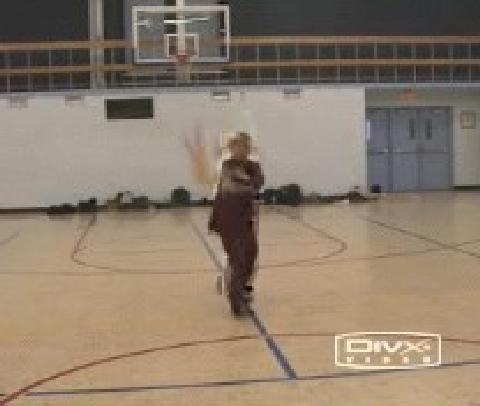
Sifu Wong demonstrating the vertical spinning of the Single Knife
Question 1
My family line is from a very old tradition, and we came from Korea. There are not many left in my family line today. Most of my family members have taken martial arts as a sport or as a joke. Only my great grandfather and a few distant relatives treated it seriously. This makes finding answers very difficult.
Before my great grandfather left us, he passed on much of what he knew to me. He was our family's apothecary as well as the last keeper of our family's secrets. This included a kind of focus meditation and a very old family martial art. Sadly, his passing has left much of my “mudo” (martial culture) upbringing incomplete and I have searched ever since for a mentor or guide.
Living in the Western world and searching for the Eastern wisdom has left me with very little real help. The schools and teachers I have found are either hobby martial artists, bitter and disappointed athletes, or old masters who are great teachers of their own art but are not open for questions or guidance. You are the last link I have to my family's deep past.
I hope you can help me to answer a few questions.
— Lee, USA
Answer
I am glad you are determined to keep your family art alive. It is not easy and it calls for dedication, but it is certainly worth the time and effort. If there are any ways I can help you, please let me know.
Question 2
Is staff spinning an effective technique for keeping opponents at a distance? Or is the spinning technique actually meant to position the staff for openings? Is it simply for sport and exercise?
Answer
Yes, staff spinning is an effective technique for keeping opponents at a distance. The spinning techniques can also be used to position the staff for openings. There are also other martial functions. But most people who perform staff spinning today have missed the martial functions, and perform it simply for sport and exercise.
The exponent can also spin a spear, a Big Knife, a Single Knife, Double Knives, Butterfly Knives, Double Rods, Double Whips, a Soft Whip, and other weapons. The principles are similar, though there may be finer points of difference between different weapons. You can see some of these weapons in spinning movements if you refer to the “Kungfu Weapon” section of my webpage on Video Galore.
The staff (unless it is a short one) is usually held with both hands at the middle of the staff, but sometimes it may be held with the hands at either end, particularly for horizontal spinning.
Staff spinning may be divided into two broad categories — vertical spinning and horizontal spinning. Vertical spinning can be sub-divided into “close movement” and “open movement”. During staff spinning, if the top end of the staff moves forward in its downward movement during the process of making circles or figures-of-eight, it is referred to as “close movement”. If it first moves backward in its downward movement, the spinning is referred to as “open movement”.
If an opponent throws darts or missiles at a staff spinning exponent, the darts or missiles will be deflected to the ground if the spinning movement is “close”. If the movement is “open”, the darts or missiles will be deflected upwards. If the exponent is using a Big Knife (a bladed weapon attached to the end of a long shaft) instead of a staff, “close” spinning movement will cut the opponent downward, whereas “open” spinning movement will cut him upward.
Horizontal spinning can be at top, middle or low levels (at the levels of the head, waist and legs). The horizontal spinning movement can be clockwise or anti-clockwise. Horizontal spinning is an effective technique to clear a way for escaping an ambush by multiple opponents.
It is very important when applying spinning techniques to ensure that the spinning weapon does not slip off the hands. Hence the opponent must hold the weapons firmly but agilely.
You may be interested to know the names of some spinning patterns when using a staff in Shaolin Kungfu as follows.
- Close vertical spinning — “Double Butterflies Flying”.
- Open vertical spinning — “Big Blossoming of Plum Flowers”.
- Clockwise horizontal spinning — “Wild Wind Sweeps Leaves”.
- Anti-clockwise horizontal spinning — Jade Belt Surrounds Waist”.
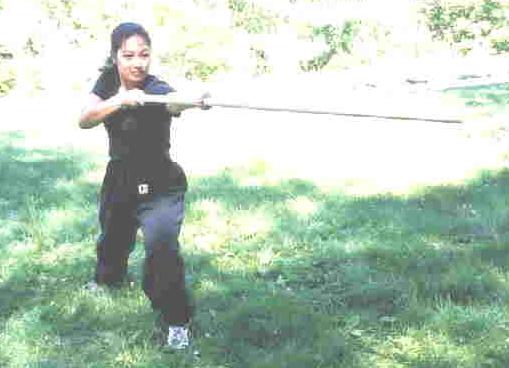
Sifu Emiko Hsuen demonstrating the Flowing Water Staff
Question 3
It is taught that Taichi Wushu originally came from four basic movements. Is this true?
Answer
This is not true. Taichi Wushu, or Taijiquan, evolved from Shaolin Kungfu. I believe that after practicing his Shaolin Kungfu, Zhang San Feng went into Standing Zen, or the Wuji Stance, to enter Tao.
In the extreme stillness of the stance was generated movements. Zhang San Feng flowed with the movements, which were induced by his chi flow. When the movements were gentle, resulting in Zhang San Feng swaying gently, they were poetically described as “Flowing Breeze Swaying Willows”. When the movements were vigorous, resulting in Zhang San Feng moving about gracefully, they were poetically described as “Flowing Water Floating Clouds”.
Later these “flowing water floating clouds” movements were stylized into patterns that evolved into Wudang Kungfu. Much later Wudang Kungfu evolved into Taijiquan.
The original movements where Zhang San Feng moved about gracefully were poetically called “Flowing Water Floating Clouds Hands”. Over time the term was shortened to just “Cloud Hands”.
“Cloud Hands” was originally a generic term. It did not refer to a particular form of movement or pattern, but referred to movements or patterns that were continuously flowing. When the great master, Yang Lu Chan, practiced Taijiquan, he mainly practiced these flowing movements.
In Chen Style Taijiquan, which was actually the style of Taijiquan Yang Lu Chan practiced (Yang Style Taijiquan came after his grandson, Yang Deng Fu, modified it), these movements were collectively called “Cloud Hands”. A particular type of movement was stylized into a pattern now called “Lazy to Roll up Sleeves”.
In Yang Style Taijiquan there is a pattern called “Cloud Hands”, which stylized outward circular movements of the hands. Other movements were stylized in a pattern called “Grasping Sparrow's Tail”, which has become the most typical pattern in this style. Traditionally these movements in “Grasping Sparrow's Tail” were stylized into four techniques, namely “peng”, “lu', ”li“ and ”an", which are warding off, rolling back, pressing forward, and pushing on contact. You probably referred to these four techniques when you mentioned that Tai Chi Wushu originally came from four basic movements.
In our school, however, we identify one more technique besides the four, namely “cheng”, or sinking. We also have names for the patterns of these techniques, namely “Immortal Waves Sleeves”, “Double Dragons Play with Pearl”, “Pushing Boat According to Flow of Stream”, “Open Window to Look at Moon” and “Black Bear Sinks Hips”.
Question 4
Do martial arts traditionally require a meditative focus such as Bagua, Karate, and Tai Chi instead of pure physical arts like Muai Thai, Kickboxing, etc. Do they also follow the same principle?
Answer
To be effective, all martial arts require some mental focus. How this is accomplished may vary vastly in techniques used and in depth.
Internal arts like Bagua and Taijiquan pay much attention to this aspect, and therefore their techniques are more sophisticated and profound. These internal arts have specific methods, like zhan zhuang and jing zuo (stance training and meditation) to train meditative focus.
Martial arts that pay more attention to physical forms for their combat effectiveness generally do not have such specific methods. They acquire their mental focus during the process of their physical training or sparring themselves. In other words, Bagua and Taijiquan practitioners train zhan zhuang and jing zuo first to acquire metnal focus besides other benefits, then they apply this acquired meditative focus in their sparring or fighting, whereas Muai Thai and Kickboxing practitioners go straight to sparring and attempt to be focused.
Personally I would place Karate in the category of Muai Thai and Kickboxing, and not in the category of Bagua and Taijiquan as you have done. Nevertheless, I am speaking here of ideal conditions.. In today's situations where much of the essence of Bagua and Taijiquan have been lost, most Bagua and Taijiquan practitioners nowadays do not train zhan zhuang and jing zuo.
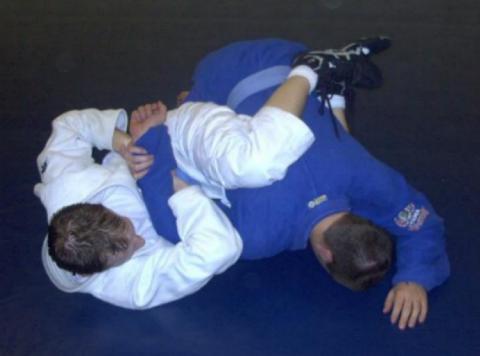
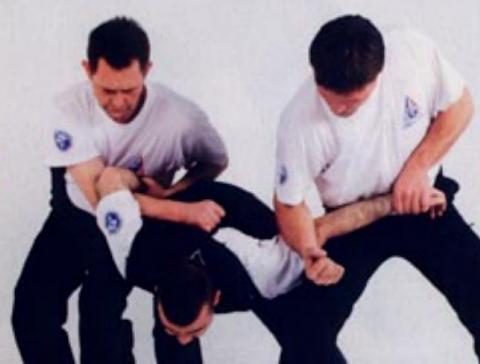
How would you release yourself from the locks?
Question 5
Can a martial art be “reborn” from a complete set of basics if their underlying philosophies are also included and understood?
Answer
Yes, it can. This is one big advantage of a martial art with a carefully recorded philosophy and a detailed description of its movements over newly invented martial arts with little or no history and literature. A master who understands the philosophy and is skilful at the basics can revive a forgotten martial art to its former glory.
Without being presumptuous, this is what we sincerely believe we are doing in our Wahnam Taijiquan. Our example may give you inspiration as well as guidance in your noble effort to revive your family art.
If you look at the type of Taijiquan typically practiced today, it is easy to find that it is very different from what Taijiquan was typically practiced in the past as revealed in its rich philosophy and literature. The rich records of Taijiquan unmistakably mentioned that it was an internal martial art. But there is nothing internal and nothing martial in most of the Taijiquan practiced today.
Even when we examine Taijiquan at its most basic, physical level, it was clearly recorded that Taijiquan movements were circular and that the movements were controlled by the waist. A Taijiquan practitioner should move his left first before he moved his right, and should move backward before he moved forward, and vice versa. Many practitioners today not only do not do these things, they do not even understand what all these mean.
At more advanced levels, it was recorded that practicing Taijiquan would develop internal force and result in spiritual joys. Most Taijiquan practitioners today have no experience of these benefits, and mistakenly think they were myths.
There were also records of how to apply Taijiquan in combat. Such Taijiquan combat applications are also found in many Taijiquan books written in Chinese still available today. For example, if an opponent attacks with a punch, a Taijiquan exponent could respond with “Throw Knee Twist Step” (known as “Green Dragon Shoots Pearl” in Wahnam Taijiquan); if he attacks with a side kick, the Taijiquan exponent could respond with “Low Stance Single Whip”. But most Taijiquan practitioners today do not even understand how to apply these patterns, not to mention their lack of the necessary skills to do so.
In Wahnam Taijiquan we learn how to do all these, i.e. practicing the art according to the basics and philosophy as stated in Taijiquan classics. The interesting point is that many modern Taijiquan practitioners when seeing us perform Taijiquan, may remark that ours is not Taijiquan because it looks so different from what they practice. But we are happy that what we practice is so much closer to what past masters described what Taijqian was, and the benefits we derive from our practice correspond closely to what Taijiquan was purported to give.
Question 6
I have literally just started practising standing meditation, and as I attempted this I began swaying, which as you say might be expected of such an exercise. However, I subsequently found myself falling backwards. Could this be due to chi flowing from the lower energy field to the upper energy field? And if so, is it possible to have this level of chi before even initiating any exercises?
— Alasdair, Scotland
Answer
Yes, what you experienced was chi flowing to your back from your lower energy field to your upper energy field. It is possible to have this level of chi flow even before initiating any exercises if you are sufficiently relaxed.
Chi flow is natural. It happens all the time in any person regardless of whether he (or she) practices chi kung, meditation or any other art. But for various reasons, such as mental stress, physical tension, viral attack or injury, this chi flow may be interrrupted. If the interruption persists for some time, it will results in pain or illness.
Question 7
Could you please detail the process used to acquire the art of lightness? I would like to know this so I could go about acquiring it in the future.
Answer
I have explained the Art of Lightness a few times in my question-answer series. Please do a serach for the answers.
Briefly, there are three approaches — the physical, the energetic and the mental. Physically you gradually add weights to your body as you practice jumping and running systematically every day. Energetically you direct your chi to float as your jump, or to move your legs as your run. Mentally you will yourself to jump high and run fast. These three approaches are integrated.
My brief explanation above is for intellectual curiosity. I would strongly advise you against practicing the Art of Lightness without the supervision of a master. The risk of mistakes resulting in serious side effects is high when practicing on one's own without expert guidance.
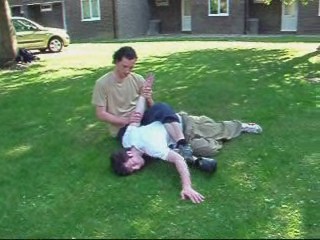

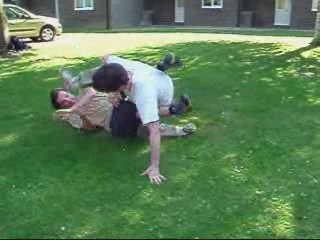

The series of photos show how a defender uses Shaolin Kungfu to overcome being pinned-down.
Question 8
Thanks a lot for answering my last question on combat application. Shaolin counter techniques are indeed flowery and extremely effective for self defense. Could you please explain how I can counter the holds shown in the new pictures. (Please see the pictures before Question 5.) I usually have difficulties escaping these holds if they are already in place and the attacker is putting all his weight onto my elbow or shoulder joint.
— Torsten, Germany
Answer
Your e-mail arrived when I was conducting some Shaolin Kungfu courses at a Summer Camp in England. I thought it would be a good idea to post your questions to some assistant instructors who were present, to test their kungfu understanding. Tim, our instructor from England, had a video-camera then, so we could capture the actions.
I told the attackers to be realistic and so long as they take care not to break the responder's arm they should really press hard and not let go voluntarily. I was actually quite surprised and very happy that they overcame the combat situations quite easily. In fact, I told them to slow down their action so that those watching the videos could see their movements.
Two principles are important in both situations when you are caught in an awkward position. First, you have to remove the possibility of the opponent breaking your elbow. Secondly, you have to use his force and turn it back against him.
In the first picture, you can release the threat on your elbow by first relaxing your arm and then twisting it in a snake-like fashion in a clockwise direction. Simultaneously row your body over to make use of the opponent's momentum. Then swing one leg over your opponent's body and ride on him, twisting his leg to control him. This pattern is called “Zhang Kuo Lao Riding a Donkey the Reverse Way”. Please see this video clip for the movements.
In the second picture, you should first prevent the attackers breaking your elbow by relaxing your arm and bending it slightly. Swing your arm downward while moving back simultaneously, using a Shaolin pattern called “Black Crow Folds Wings”. Then move forward and turn around to face your two opponents. Please see the video clip here. Some internal force is needed to execute this pattern effectively. Moreover, the demonstrator, Innes, is quite big sized, which may give the mis-conception that he overcame the combat situation with mere strength.
Hence, I asked Hubert, who is smaller in size, to demonstrate how he could release the hold from two opponents who are bigger in size than him. Please see this video clip. Hubert first bends his elbow slightly to prevent the opponents breaking it. Then he circulates his hand to release their hold, followed by straightening his arms to strike the opponents' side ribs with his palms, using the pattern “Big Bird Spreads Wings”.
LINKS
Selected Reading
- Stances in Taijiquan and Shaolinquan
- Combat Sequence Training (Part 2)
- Defence Footwork in Wahnam Taijiquan
- Moving into an Opponent using Arrow-Step
- Right and Wrong Ways to Yield in Wahnam Taijiquan
